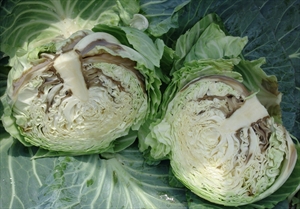Lettuce soft rot, bacterial soft rot
Pacific Pests, Pathogens and Weeds - Online edition
Pacific Pests, Pathogens & Weeds
Lettuce soft rot (289)
Pectobacterium carotovorum subsp. carotovorum (previously, Erwinia carotovora pv. carotovora, Erwinia carotovora subsp. carotovora, and also Erwinia aroideae). Other bacteria species may also be present in the soft rots.
Asia, Africa, North, South and Central America, the Caribbean, Europe, Oceania. It is recorded from Australia (lettuce, potato), Federated States of Micronesia (banana, cabbage, Chinese cabbage, onion), Fiji (cabbage, carrot, cauliflower, potato, watermelon), Palau (banana, cabbage, Chinese cabbage), Marshall Islands (banana), and Papua New Guinea (Chinese cabbage, Pandanus, potato), and Solomon Islands (taro in storage).
Wide. Common on banana, cabbage, capsicum, carrot, celery, Chinese cabbage, ginger, lettuce, potato, spinach and other leafy greens, squash and other cucurbits, tomato, and more.
Bacterial soft rots affect the leaves and stems. Water-soaked spots occur on the outer leaves and form large brown slimy areas which progress to the inner leaves of the 'head' (Photo 1). The rots in the outer leaves cause the leaves to wilt, and eventually the stem (Photo 2), which results in collapse of the plant. Soft rot is important in the field during warm wet weather, and also important in transit and storage. [See also symptoms on Chinese cabbage (see Fact Sheet no. 101).]
The bacteria that cause soft rots occur in the soil; they infect through wounds made by insects, and those made when planting, weeding, harvesting, and transport. Infection also occurs through natural openings when water is present.
Spread is by rain splash, knives used for cutting (rots occur later in storage), and insects. In storage, rots also occur when infected leaves are in contact with those that are healthy. Survival is in the decaying remains of crop debris in the soil.
An important disease in hot wet weather with outbreaks reported causing total crop destruction.
Look for outer leaves which have wilted, sometimes leading to rots of the stems. Look for the brown slimy soft rots of the head. There are PCR (molecular) methods available for the identification of this bacterium.
CULTURAL CONTROL
Cultural practices are important in preventing outbreaks of this disease. There is no treatment for the affected crop, but for future crops carry out the following cultural practices.
Before planting:
- Avoid planting in soil that becomes waterlogged: plant lettuce on raised beds.
During growth:
- Do not plant lettuce too close to each other: allow wind movement between the plants.
- Mulch plants with, e.g., straw or dried grass; this is important as it not only conserves water during dry times, but also reduces the chance that bacteria will be splashed during heavy rains from the soil to healthy plants.
- Avoid over-head irrigation, use drip irrigation in preference.
- Be careful when weeding so as not to damage the leaves and allow entry of bacteria.
- Clean and disinfect equipment used in harvesting. Use household bleach.
- Remove plants with signs of soft rot as soon as it appears, and burn or bury the plants deeply.
- Avoid harvesting lettuce when they are wet.
After harvest:
- Handle plants carefully to avoid wounding the leaves.
- If possible, keep lettuce cool after harvest; 4°C is ideal.
- Collect crop debris and burn or bury it deeply in the soil before a new crop is planted.
- Rotate with other crops that are resistant to this disease, e.g., beans, cucumbers or tomatoes. Ideally, use a crop rotation of 2-3 years.
CHEMICAL CONTROL
This is not an option for this soil borne disease, unless the problem is associated with soil insects. In this case, use synthetic pyrethroids.
____________________
When using a pesticide (even a biopesticide), always wear protective clothing and follow the instructions on the product label, such as dosage, timing of application, and pre-harvest interval. Recommendations will vary with the crop and system of cultivation. Expert advice on the most appropriate pesticide to use should always be sought from local agricultural authorities.
AUTHOR Grahame Jackson
Information from Diseases of vegetable crops in Australia (2010). Editors, Denis Persley, et al. CSIRO Publishing. CABI (2019) Pectobacterium carotovorum subsp. carotovorum (bacterial root rot of sweet potato). (https://www.cabi.org/cpc/datasheet/21913). Photo 1 Sandra McDougal, NSW Department of Primary Industries, Yanco. Photo 2 Gerald Holmes, California Polytechnic State University at San Luis Obispo, Bugwood.org.
Produced with support from the Australian Centre for International Agricultural Research under project PC/2010/090: Strengthening integrated crop management research in the Pacific Islands in support of sustainable intensification of high-value crop production, implemented by the University of Queensland and the Secretariat of the Pacific Community.





